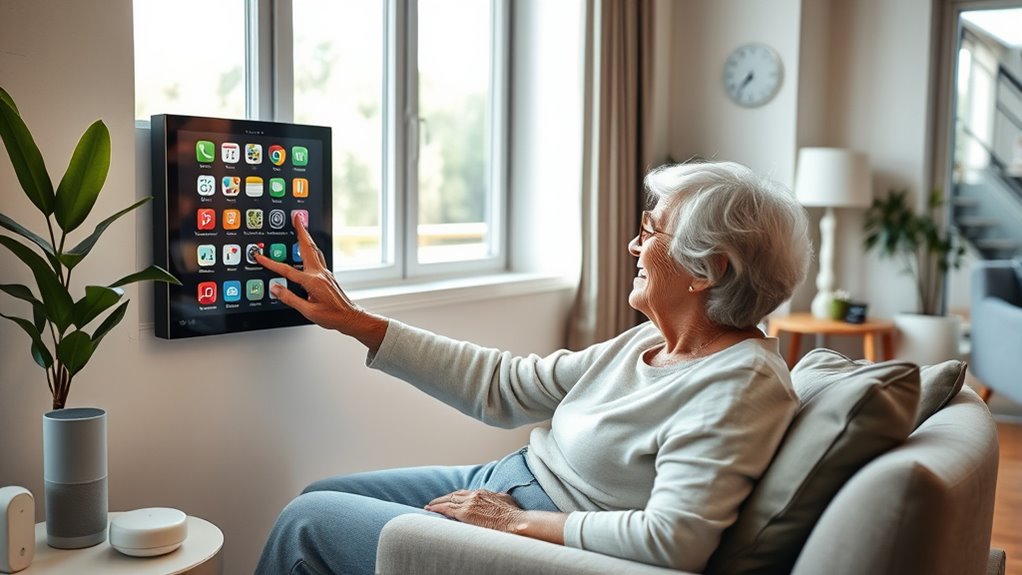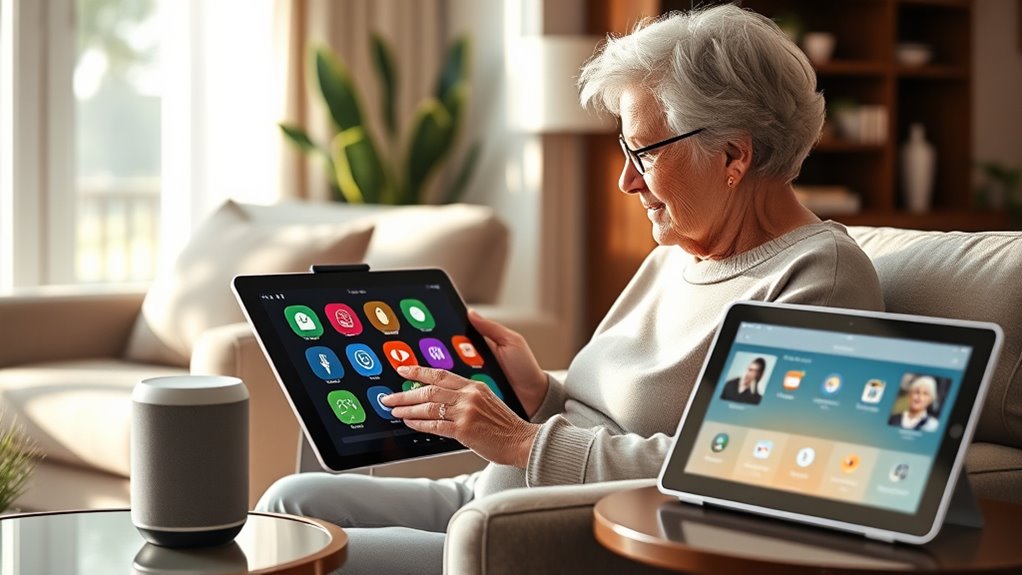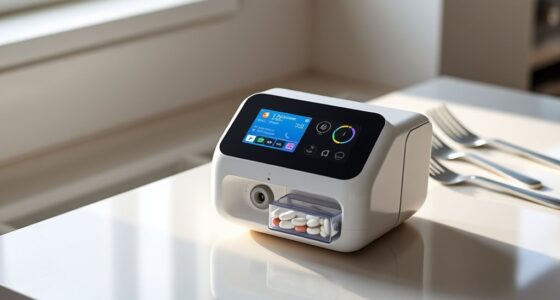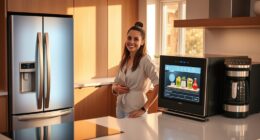To choose the right smart home platform for seniors, focus on systems that prioritize voice control, security, and ease of use. Look for options compatible with popular voice assistants like Alexa, Google Assistant, or Siri, making daily commands simple. Consider systems that support diverse devices to grow with your needs and offer customization options for safety and convenience. Exploring reviews and demos can help you find the best fit—there’s more to uncover to guarantee a seamless setup.
Key Takeaways
- Choose platforms compatible with popular voice assistants like Alexa, Google Assistant, or Siri for easier control.
- Prioritize user-friendly interfaces and simple setup options to accommodate seniors’ tech comfort levels.
- Ensure the system offers customization and scalability to add devices as needs change over time.
- Opt for integrated security features like cameras and locks for enhanced safety and remote monitoring.
- Select platforms supporting multiple device brands for flexible, tailored smart home solutions.

Smart home systems offer a versatile way to tailor your living space to your needs and preferences. If you’re a senior looking to enhance safety, comfort, and independence, choosing the right platform can make a significant difference. One of the key features to consider is voice control. With voice commands, you can effortlessly manage lights, thermostats, and even appliances without needing to navigate complex menus or learn new tech skills. Voice control simplifies daily routines, allowing you to adjust the environment with just a few spoken words, which is especially helpful if mobility or vision issues exist. When selecting a system, check if it integrates smoothly with voice assistants like Amazon Alexa, Google Assistant, or Apple Siri. These platforms enable you to create a hands-free experience, making your smart home more accessible and easier to operate.
Voice control in smart home systems makes managing lights, thermostats, and appliances easy and accessible for seniors.
Security integration is another essential aspect to focus on. You want a system that not only offers convenience but also enhances your safety. Look for platforms that seamlessly connect security devices such as cameras, doorbells, sensors, and locks. With integrated security features, you can monitor your home remotely, receive real-time alerts of any unusual activity, and control access easily. For seniors, this integration can provide peace of mind, knowing they can double-check doors are locked or see who’s at the door, all from their smartphone or voice-activated device. Many platforms allow you to set up routines that automatically trigger security measures—like turning on outdoor lights if motion is detected at night or locking doors at bedtime. Additionally, compatibility across multiple devices ensures you can customize your smart home system to suit your specific needs and preferences.
When customizing your system, make sure the platform you choose supports multiple devices and is user-friendly. Compatibility across brands is essential so you can select the best security cameras, smart locks, or sensors without worrying about technical issues. Also, consider the system’s ability to grow with your needs. As you get more comfortable or your requirements change, you’ll want a platform that allows easy additions or upgrades.
Ultimately, the right smart home platform for seniors combines intuitive voice control with robust security integration. It should empower you to manage your home confidently, providing convenience, safety, and peace of mind. Spend some time exploring different options, reading reviews, and possibly trying demos. The goal is to find a system that feels natural to use, simplifies your daily routines, and keeps your home secure—all tailored to your unique lifestyle.
Frequently Asked Questions
Can Smart Home Systems Be Customized for Specific Health Conditions?
Yes, smart home systems can be customized for specific health conditions. You can implement health-specific adaptations, such as alerts for medication times or emergency calls. Personalized device settings allow you to tailor features like lighting, temperature, or reminders to suit your health needs. This customization guarantees your environment supports your well-being, providing safety and convenience that adapt precisely to your health requirements.
What Security Measures Protect Seniors’ Data in Smart Home Platforms?
Your data is protected by top-tier security measures that are as powerful as a fortress. Data encryption keeps your information secure, making it unreadable to outsiders. Access control ensures only authorized people can view or change your data. These safeguards work together to shield your personal health info and device settings, giving you peace of mind knowing your smart home system prioritizes your safety and privacy above all else.
Are There Voice-Activated Options for Easier System Control?
Yes, many smart home platforms offer voice command options, making system control easier for you. You can activate hands-free control, allowing you to manage devices simply by speaking. This feature is especially helpful for seniors who may have mobility or dexterity challenges. With voice-activated options, you can adjust lights, thermostats, and security systems effortlessly, providing greater independence and convenience in your daily routines.
How Do Platform Compatibilities Affect Customization Choices?
Platform compatibility affects your customization choices because it determines which devices and systems can work together seamlessly. You’ll want a platform that supports your existing devices and allows easy device integration, making setup smoother. If your chosen platform isn’t compatible with certain devices, you’ll face limitations and extra hassle. So, confirm the system you pick offers broad platform compatibility to maximize your device options and create a cohesive, user-friendly smart home experience.
Can I Integrate Emergency Alert Features Into Existing Smart Home Setups?
Yes, you can integrate emergency alert features into your existing smart home setup. Look for systems that support emergency integration and system alerts, ensuring they work seamlessly with your current devices. Many platforms allow you to add emergency buttons or sensors that trigger alerts to caregivers or emergency services. Check compatibility and install the necessary apps or hardware updates to enhance safety and quick response during emergencies.
Conclusion
As you gently tailor your smart home system, you create a cozy, accessible space that feels just right. By choosing the right platforms and settings, you’re weaving comfort and independence into everyday life. It’s like planting seeds of confidence, allowing your loved ones to flourish with ease. Embrace these thoughtful choices, and watch your home blossom into a haven where convenience and care blend seamlessly, making every moment a little brighter and more enjoyable.








